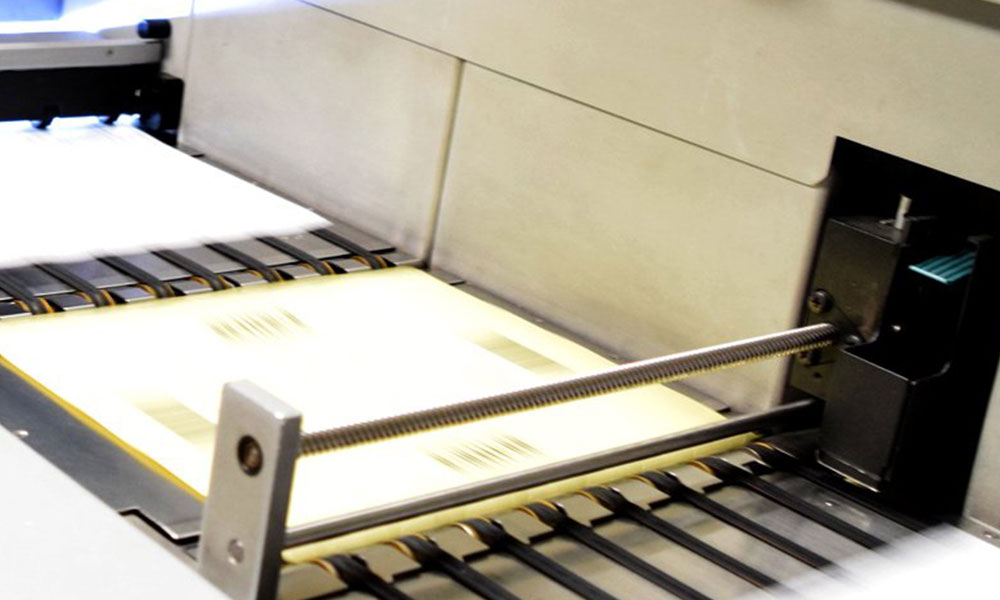At its most basic, a digital mailroom is a business process outsourcing (BPO) solution that helps organizations manage their incoming mail and messages. By scanning and digitizing inbound communication as it arrives, businesses can enjoy a host of benefits, including reduced processing times, lower postage costs, and improved document security. In addition, digital mailrooms make it easier to comply with industry or government regulations; keep track of important correspondence; and deliver faster, more seamless customer experiences.
For businesses that receive a large volume of mail — whether that be paper mail, faxes, emails, attachments, and more — daily, a digital mailroom can become an invaluable part of operations. By outsourcing the task of managing incoming mail, businesses can free up their employees to focus on more productive activities and become much more efficient.
If you’re considering implementing a digital mailroom solution for your business, our ultimate guide will tell you everything you need to know. We’ll cover the basics of how digital mailrooms work, the benefits they can offer, and the key considerations you need to take into account when choosing a provider or determining if it makes sense to implement an on-site or outsourced digital mailroom.
Whether you’re looking to save time and money; improve your level of customer service; implement digital technologies and workflow automation into your operations; or meet your compliance obligations, a digital mailroom is likely to add serious and measurable value.
Within this comprehensive digital mailroom guide, we’ll even walk you through important questions to ask potential business process outsourcing (BPO) partners. You’ll be prepared to make an informed decision about whether a digital mailroom is right for your business and identify a digital mailroom partner that’s best suited for your organization’s needs. Let’s get started.
- What is a digital mailroom? How does it work?
- How do digital mailrooms add value?
- Are digital mailrooms compliant and secure?
- How are documents handled after they’re digitized?
- How are incoming checks handled within a digital mailroom?
- Why should I reduce paper in my organization?
- Should I insource or outsource my mailroom function?
- How much money could I save by outsourcing my mailroom function?
- What are some potential risks when implementing an outsourced digital mailroom?
- How can I choose the right digital mailroom business process outsourcing (BPO) partner? Should I create a digital mailroom request for proposals (RFP)?
What is a digital mailroom? How does it work?
Often used by consumer-facing organizations such as banks and insurance companies, a digital mailroom is a central location where all of an organization’s incoming mail and messages (paper, electronic, emails, attachments, faxes, etc.) are received, scanned, and routed electronically. Documents are scanned as duplex, black and white, or color, depending on your preferences. Even oversized items larger than A3 and unique or sensitive items like checks or bound/stapled items can move through a digital mailroom process.
The digital mailroom concept is often part of a larger business process outsourcing (BPO) initiative, adhering to strict service level agreements (SLAs). For example, a company may promise to respond to a customer complaint or a product/service application within a certain period, and a digital mailroom makes the entire process faster, more efficient, and trackable. An effective digital mailroom provider should be able to guarantee inbound mail will be digitized and routed within 24-48 hours of receipt. They should also be able to guarantee high accuracy levels of data capture and image quality. (At this point, higher than 98% is an accepted industry standard.)
Service providers like Docufree leverage streamlined workflows, best-in-class, high-speed scanners, and equipment (sometimes scanning up to 10,000 pages per hour), and seasoned teammates to process the mail for its clients. Within the outsourced digital mailroom operation, an individual handles bulk scanning and indexing software and then captures data from each piece of mail. Digitized documents can be digested, interpreted, and delivered to an organization’s existing business system or platform, or many digital mailroom vendors also offer their own hosted document management solution. In many cases, patterns and knowledge gleaned from inbound-focused digital mailrooms can also be used to optimize a business’s outgoing forms and mail, providing a complete end-to-end solution for an organization’s communication needs.
There are many benefits of using a digital mailroom. Digital mailrooms can help organizations to improve their efficiency and productivity and also provide tracking and metrics to identify pinch points and areas for improvement within workflows. In addition, digital mailrooms can help to reduce the amount of storage space required for physical documents. With certain industries, copies of records must remain on file for a set amount of time. When those records are digitized and securely stored, compliance requirements can be met without unnecessary risk.
For businesses that receive a large volume of postal mail, a digital mailroom can provide considerable cost savings. Traditional mailrooms require personnel and labor management. The US workforce continues to grapple with complex workforce attraction and retention challenges. Consistently staffing a stand-alone, in-house mailroom is not easy.
How do digital mailrooms add value?
Digital mail can be incorporated into other processes in a way that physical documents never can be. This is because they can integrate Optical Character Recognition (OCR) and Intelligent Character Recognition (ICR) technology to extract useful data, then classify and route documents based on defined business rules. Through detailed quality checks and piece-by-piece tracking, digital mailrooms drive money-saving improvements and efficiencies while mitigating human error and risk.
Outsourced digital mailrooms can be further extended into an organization using application programming interfaces (APIs) so that digital documents can flow into relevant systems such as finance and HR. Instead of incoming communications from partners, customers, and suppliers arriving in one single ‘bucket’, it can be automatically streamed to the right team, faster.
Another benefit is that incoming mail can be combined with other communication channels, such as email or phone calls, to ensure everything is placed into the relevant workstream. This enables customer-facing teams to access all the relevant information they need to action processes or resolve queries.
The strategy and processes of implementing a digital mailroom also allow you to step back and consider if you’re operating most efficiently particularly when it comes to your inbound communications. When we talk about a digital mailroom, we essentially talk about the evolution in mailroom technology — and sometimes even an organization’s overall digital transformation strategy.
As the power of artificial intelligence and robotic process automation continues to grow, digital mailrooms will move far beyond being mere replacements for the physical mailrooms of the past. Instead, they will act as the information hub of every organization, speeding up and improving every process that relies on document sharing.
Are digital mailrooms compliant and secure?
Yes. Security of sensitive data and documents is always an important consideration whether employees are working from home or in a typical office setting. Firewalls, VPN capability, and IP protocols are typically in place to ensure the security of staff and customer data. Employees must always be mindful of how they share information; whether through email attachments, text messages, or clickable links, it’s easy to get complacent. Additional suggestions to protect data include: using encryption (256 bit if possible); transferring information through File Transfer Protocol (FTP); and password-protecting your files. Ensure you are communicating openly and frequently with remote employees about approved document-sharing channels and security protocols.
How are documents handled after they’re digitized?
After original documents are received and processed through the digital mailroom, the vendor should either confidentially and compliantly destroy or return the mail to the customer. Before your documents are returned to you or are moved to the shredding phase, they should be stored appropriately and safely. Sometimes mail is stored for 30, 60, or 90 days, and then an action is taken. In some instances, clients opt to retain their original documents with a selected long-term storage vendor. If your digital mailroom partner doesn’t provide long-term storage options, they should be able to recommend a few trusted vendor partners or two that can assist.
How are incoming checks handled within a digital mailroom?
Depending on your existing setup, a digital mailroom will likely allow you to process inbound checks faster than if they were to come into a traditional mailroom. Two options exist for processing checks with a digital mailroom, depending on your needs.
Inbound checks can be scanned (digitized) and certain fields — like check number, amount, account number, check date, payable to, and more — can be exported for verification and tracking. This information can then be sent into a client system as an automated check reconciliation report and/or digitally delivered to a bank if the digital mailroom vendor has been granted permission to deposit to the specific account and can transfer the data accordingly.
Another option is to receive inbound checks and then mail the hard copies back to the customer. In this case, the client would handle and deposit the checks on their own.
Why should I reduce paper in my organization?
The benefits of digitizing documents and communications are now well-understood: speed, accuracy, and better productivity can all be achieved by reducing the amount of physical paper changing hands in organizations.
It may be that an organization’s decision to reduce paper is triggered by a specific event, such as an office move or refurbishment, a merger or acquisition, a change in legislation, or an external event, such as the COVID-19 pandemic. A goal to reduce paper is often low-hanging fruit when it comes to supporting an organization’s environmental, social, andgovernance (ESG) initiatives.
But before simply ditching your filing cabinets and emptying your staff’s desk drawers, it pays to think about what paper-based processes the organization still has, why it has them, and which teams make use of them.
Does the paper create an action that is linked to it, and can that be replaced with a digital process that is more efficient? By carrying out a detailed audit, organizations can determine exactly which paper documents they can get rid of, where it’s safe to digitize and how much space they can reclaim.
Your audit will undoubtedly show that one of the best ways to reduce paper is to eliminate it at source when it enters your organization in the mailroom. By contrast, a paper document must be taken out of a folder, physically read by a human, and manually taken on to the next stage of a process. When information needs to be re-entered into a system, errors can creep in and destroy the concept of having one golden version of the truth.
Once it is digitized, it can be used as a single source of data, no matter who is accessing it and for what purpose. Digital documents are also more conducive to collaborative working than paper, especially when people are working remotely or in different locations to other team members.
Should I insource or outsource my mailroom function?
The factors that are relevant when deciding to convert to a digital mailroom relate mainly to volume and complexity. Set-up costs, whether for in-house or outsourced services, are prohibitive for organizations with mail items in the low hundreds per week. The organizations that benefit the most are those handling thousands of items every day.
Organizations also tend not to have the expertise needed to run digital mailrooms in-house, in contrast to third parties that constantly invest in skills, equipment, and technology to stay ahead of the game.
The reasons for outsourcing digital mailrooms are many and varied. For example, some companies with expensive city offices may not want to use the space for processing mail, or they may want to reduce the number of mailrooms they operate.
The main factors when deciding to outsource are cost and added value. Even the most basic outsourced digital service will cost less than maintaining a physical mailroom over time. Still, the fact that it delivers resilience for the future and the potential for additional services offered by specialists in the sector makes outsourcing the smart choice. We’ve compiled a blog with more details specific to this question, and you can click here to read it now.
How much money could I save by outsourcing my mailroom function?
One of the biggest drivers for outsourcing a mailroom function is to reduce costs. Actual cost savings vary by implementation, but as a general rule of thumb, organizations can save between 20% and 30% of their investment in a physical mailroom or mail-handling department by outsourcing their mailroom to a third-party supplier.
In turn, this helps to improve access to information that was previously hidden away in filing cabinets and desks. Documents can be accessed and shared, worked on collaboratively and made available even when buildings are closed down to employees.
What are some potential risks to implementing an outsourced digital mailroom?
With any significant shift in process or technology integration comes measurable risks. It’s important to assess potential challenges up front, and a seasoned vendor partner will be able to walk you through typical digital mailroom risks and operational mitigation strategies in full detail. Once you understand the existing infrastructure, operations, and key resources involved, a digital mailroom partner should be able to provide you with a hypothetical approach and methodology that addresses your organization’s specific risks and challenges.
Some of the most common risks we’ve seen when implementing a digital mailroom include:
- Scope: If purchased products (hardware or software) are included, a vendor should provide complete product details, including identification numbers, titles, abbreviations, version numbers, and release numbers. Information on any of the customer’s software or hardware that will be affected by the transition should be considered.
- Risks and Contingencies: Risks should be classified or grouped into related sets for optimal effectiveness of management and mitigation.
- Strategies: When ironing out a transition strategy, a vendor should be able to suggest appropriate options, including the advantages and disadvantages, risks, estimated time frames, and estimated resources for each. Then, the team can work with the client to select the option that poses the least amount of risk, provides the least disruption to the business, and yields the most efficiency.
- Transition Schedule, Tasks, and Activities: Once you’ve decided on the ideal digital mailroom transition strategy, be sure to ask about a detailed schedule, including milestones, dependencies, timelines, and dates.
- Transition Resources: Resources are finite, and you’ll need to identify upfront which specific resources are needed to complete the transition/deployment phase of the project. Resources include hardware, software, facilities, personnel, and other special resources (e.g., service and maintenance contracts).
- Reporting and Communication Procedures: Defining the reporting and communication procedures for the transition period (before, during, and after) is extremely important. Decide on the type of evaluation (review, audit, or test) and be aware that some anomalies might be identified during the performance of these evaluations.
- Transition Acceptance: A vendor will work with you to establish and document the transition acceptance criteria, which may include specific functionality of current processes, quality of SLA, and integration into the client’s existing systems or software.
- Change Control: A good digital mailroom implementation sets up the client and vendor to become more in tune and streamlined over time. A formally established change control process ensures expectations are communicated and defined. A standard ISO process should be in place, so specific client needs and changes are documented and integrated effectively.
- Transition Team: A role-specific transition team on the vendor and client side must be put into place for collaborative, cohesive implementation. Ask about how easy it is to get in touch with your vendor’s implementation team and what the process is. Does the vendor work through implementation with structured meetings and check-ins, or is it more ad-hoc and communication as needed? Define what an expected response time should be so everyone is on the same page.
Post-Implementation: The post-implementation process includes a high-level timeline and a list of post-implementation activities. These might include items like the posting/distribution of FAQs and other key information; monitoring/tracking of help desk tickets; follow-up meetings with client/customer; and additional change orders or process adjustments if the digital mailroom becomes more sophisticated or can be implemented into other departments or organizational processes.
How do I choose the right digital mailroom business process outsourcing (BPO) partner? Should I create a digital mailroom request for proposals (RFP)?
Let’s say you’ve read all the research, made your case to leadership and the board, and you’re ready to take the next step in implementing an outsourced digital mailroom. It’s time to identify the right partner for your organization. You’ll likely want to issue a digital mailroom RFP to a select group of reputable vendors. A structured RFP will help you compare “apples to apples” — allowing you to determine the strengths, weaknesses, and differences in each vendors’ digital capabilities, industry-specific experience, processes, security protocols, cost, and more.
At Docufree, we’ve seen our share of RFPs and answered all kinds of questions for potential clients. Along with the basic items to request, such as the organization name and main point of contact, we’ve compiled a list of 10 questions we’d recommend you include when creating your digital mailroom RFP. Click here to check it out.





